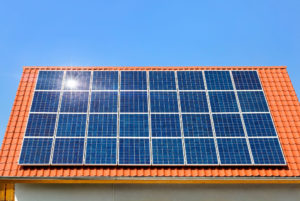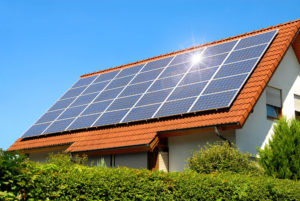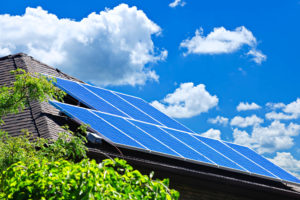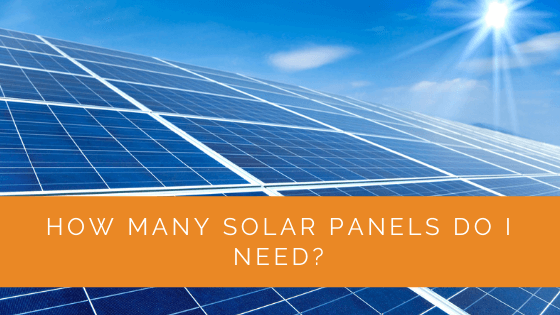Solar panels can be installed anywhere — from homes to schools, office spaces, hospitals, and beyond. So, before asking about the number of solar panels required, it is essential to understand your goals.
Goals may vary. Maybe you want to switch to renewable energy sources to reduce environmental impact. Saving money on electricity can be another such goal. In institutions like hospitals and schools, electricity usage is high. They set up solar panels to minimise direct electricity use.
A good start would be fixing your goal and then pondering concerns like the number of solar panels, power generation, set-up costs, and beyond.
The article is a compilation of multiple factors you must understand before installing solar panels. Let’s dive right into it.
Contents
- 1 Key Takeaway
- 2 Solar Panels for Houses
- 3 How to Calculate the Number of Solar Panels You Need
- 4 The Number of Solar Panels You Need: The Math
- 5 Solar Power for Different System Sizes
- 6 Solar Panels Required for Common Appliances
- 7 How Do Solar Panels Work?
- 8 The Theory Behind Solar PV Cells
- 9 FAQ
- 10 Case Study: Calculating Solar Panel Requirements for a Residential Property
- 11 Expert Insights From Our Solar Panel Installers About Determining the Number of Solar Panels
- 12 Discover the Power of Solar with Solar Panels Network
- 13 Final Takeaway
Key Takeaway
- It would be best to define your goals to determine how many solar panels you need, such as reducing environmental impact or saving money on electricity.
- The number of solar panels required depends on weather, geographical location, daily energy consumption, and panel efficiency.
- To calculate the number of solar panels, consider annual electricity usage, panel wattage, and production ratios. An 8 kWh solar panel system is often suitable for a household’s yearly electricity needs.
Solar Panels for Houses
A typical house requires between 20 to 25 solar panels to power a home’s hundred per cent electricity needs.
However, the number of solar panels also depends on factors like.
- Weather
- Geographical location
- Your daily energy consumption
- Panel efficiency
The abovementioned factors will also determine the price of solar energy.
How to Calculate the Number of Solar Panels You Need
It is essential to know how to calculate the number of solar panels you need, whether you want it for a house or a whole building.
There are three critical factors around which the calculation of the number of solar panels revolves.
- Panel Wattage
- Solar Panel Efficiency
- Annual Energy Usage
- Production Ratios
Let’s get into the parameters one by one.
Solar Panel Wattage
Solar panel wattage is commonly called the ‘power rating’ of a solar panel. It is the amount of power a solar panel can generate if the temperature and sunlight are ideal.
Typically, power ratings for solar panels vary between 250 to 400 watts. The power rating of a solar panel is inversely proportional to the number of panels required. In other words, the greater the power rating, the fewer solar panels are needed to achieve the desired energy output. Let’s consider the average wattage of 350 kW.

Solar Panel Efficiency
The solar panel efficiency measures a solar panel’s capability of converting direct sunlight into solar energy, considering ideal sunlight and temperature conditions. If a solar panel has an efficiency of 15%, it implies 15% of sun energy successfully transitions into usable energy.
The number of solar panels required follows the same relationship to efficiency as the power wattage of a solar panel. In other words, if two panels with different efficiencies are placed under direct sunlight, the solar panel with higher efficiency will generate more power.
Most solar panels in the market have efficiency ratings between 15% and 20%. Many manufacturers produce solar panels with an efficiency rating of 22%, but the maximum efficiency recorded is 23%.
Annual Electricity Usage
The annual electricity usage is the measure of electricity used over twelve months. It is measured in kilowatt-hours (kWh). The measurement of yearly electricity usage depends on the appliances present in your home and the frequency.
Everything from refrigerators, geysers, televisions, air-conditioners, lights, electric fans, and beyond are the appliances that consume energy.
To create an ideal scenario, let’s take the average annual consumption as 10,000 kWh. To get a precise calculation of your yearly electricity consumption, view your last year’s electricity bill.
Production Ratio
A solar panel system measures the production ratio. It is the total energy output of a system in kilowatt-hours to the actual system size. The ratio number depends on the sunlight your solar panel system receives.
The geographical location and the sunlight received are interdependent. The production ratio is also directly affected by factors like roof orientation, shade, roof tilt, and positioning of your house. The type of equipment the installer uses also affects the ratio.
The Number of Solar Panels You Need: The Math
The number of solar panels calculated depends on three key factors – production ratio, annual energy use, and panel wattage.
The formula is:
(System Size ÷ Production Ratio) ÷ Panel Wattage = Number of Solar Panels Required
Using the average numbers in the formula,
10,000/1.3 or 1.6/350 = 21.9
21.9 falls in the range of 20 to 25 solar panels. For a household 20 to 25 will properly support yearly electricity needs. In the same way, if you want to calculate the number of solar panels for an institution, calculate the annual electricity bill of an institution.
In conclusion, an 8 kWh solar panel system will provide adequate electricity for the year.
Solar Power for Different System Sizes
The 8 kWh solar panel system was in ideal condition in our previous calculations. However, production ratios differ. Production ratios depend directly on the amount of sunlight a place receives. It flickers between 1.3 to 1.6 depending on the city you live in, in the UK.
The table below displays various solar panel systems; the production ratio used is 1.6. Since we live in times of high consumption, 1.6 is ideal. 350 watt is taken as the perfect panel wattage in the table.
| System Size | Number of Panels Needed | Estimated Annual Production |
|---|---|---|
| 4 kW | 13 | 6,400 kWh |
| 6 kW | 19 | 9,600 kWh |
| 8 kW | 25 | 12,800 kWh |
| 10 kW | 32 | 16,000 kWh |
| 12 kW | 38 | 19,200 kWh |
| 14 kW | 44 | 22,400 kWh |
Remember, the panel efficiency determines the space solar panels will take up on the roof. The table below will show you the space a solar panel system will take.
The annual electricity usage is the most fluctuating parameter out of all. Many households have more oversized consumer products. A central air-conditioning system or a heated swimming pool increases annual energy usage significantly.
| System Size | Low Power Panels (Sq. Feet) | Average Power Panels (Sq. Feet) | High Power Panels (Sq. Feet) |
|---|---|---|---|
| 4 kW | 240 | 203 | 179 |
| 6 kW | 367 | 305 | 269 |
| 8 kW | 490 | 406 | 358 |
| 10 kW | 612 | 508 | 448 |
| 12 kW | 734 | 610 | 538 |
| 14 kW | 857 | 711 | 627 |
Calculating individual products’ energy consumption is essential to estimate the correct solar panel size. Also, a specifically designed roof will alter the size of the system. Considering an average household in the UK, the measure used is 65 by 39 inches or 5.4 feet by 3.25 feet.

Solar Panels Required for Common Appliances
After knowing the impacts of solar panel requirements based on different appliances, one thing is evident: add-on appliances will alter the number of solar panels you install.
An intelligent way to make solar energy more efficient is by pairing an electric vehicle with solar panels. Combining solar panels with electric cars helps to reduce the carbon footprint, although it should be planned and consulted.
It must be calculated and accurate if you’re finalising the installation of a solar panel system. Everything from add-on appliances to annual electricity consumption caused by general devices must be considered.
Of course, it is possible to have a solar panel system beforehand and install more panels to meet the electricity needs, but that is a waste of time and money. Start questioning how many solar panels you would need for every appliance at your home. That will give you a reasonable estimate of the solar panels you need.
See the table below for the solar panels required for different electric appliances.
| Product | Average Annual kWh Required | Estimated No. of Solar Panels Needed |
|---|---|---|
| Air Conditioning Unit | 600 | 2 |
| Central Air Conditioning | 215 | <1 |
| Electric Vehicle | 1,000 | 3 |
| Heated Swimming Pool | 3,000 | 10 |
| Hot Tub (Outdoor) | 3,300 | 11 |
How Do Solar Panels Work?
Solar panels do not have an efficiency of more than 15% to 20%. Very rarely do they touch 23%. This means only 15% to 20% of sunlight received becomes usable energy.
A common question arises: how do solar panels work? Let’s understand the basic steps of how solar panels generate power.
- The sunlight comes in contact with the panel, which creates an electric field.
- The generated electricity goes to the edge of the solar panel and gets absorbed by the conductive wire.
- The solar panels are connected to an inverter. The conductive wire drives the electricity into the inverter, where DC electricity is converted into AC to power homes and buildings.
- A separate wire flows the AC electricity from the inverter to the electric panel, called the breaker box.
- The breaker box that receives the AC electricity distributes it to various parts of the building and home.
- Excess AC electricity flows from the utility meter to the electrical utility grid. The meter runs backwards, and excess electricity is stored for future use.
The Theory Behind Solar PV Cells
The solar panels have many small photovoltaic cells. It is capable of converting sunlight into electricity. These cells are made of silicon or other semiconductors. Semiconductors can conduct electricity, creating an electric field through the electrical imbalance.
In the first stage, when sunlight hits the photovoltaic cell, the cell absorbs photons while freeing a few electrons that move in the cell. Positive and negatively charged semiconductors are sandwiched in a solar cell, creating an electric field.
The free electrons then attain motion due to the electric field towards the conductive wire. The flow of electrons is termed energy current, and the current’s strength determines the solar cell’s capability to produce electricity.
Further, the electrons strike metal plates to create an electric current, which flows into a series of wires. The wires drive the electric current, which is DC. The inverter acts as a hub to convert the DC into AC.
The DC reaches the breaker box to supply electricity to numerous parts of a building or a house. The unused electricity passes through the utility meter and propels the meter to go backwards. Excess electricity gets stored in the utility grid.
When your electricity consumption exceeds what your solar panels deliver, electricity is drawn from the grid. Primarily, electricity is used from the grid during nights when there is no sunlight or during monsoons.
Manufacturers have only been able to create solar panels with an efficiency between 15% to 20%. However, many solar panels come with efficiency levels higher than 20%. The key is to strengthen the energy current, increasing the electricity produced.

FAQ
Are There Electricity Bills for Solar Panel Systems?
Electricity bills will arrive monthly. However, the bills will be negligible, close to zero, sometimes even in negative integers. If your electricity bills are high despite a solar panel system, you must re-evaluate the size of your system.
The primary reason for a high electricity bill despite a panel system is the extra add-on appliances like a central air-conditioning system or a heated swimming pool. Evaluate how many solar panels each device would require and adjust as soon as possible.
What Are the Disadvantages of a Solar Panel System for a Household?
Even though solar energy is renewable, it sometimes fails to align with our lifestyle. There are two demerits of solar panel systems.
- They have high upfront costs. The costs increase as you look for solar panels with higher efficiency. Also, the installation charge and the arrangements required to run the system successfully cost money, effort, and time.
- Solar energy is intermittent, so you cannot expect sunlight twenty-four hours a day. Weather conditions and geographical locations also affect the sunlight you receive.
Is It Worth Installing a Solar Panel System?
The worth of installing a solar panel system depends on your annual electricity bills, geographic location, and your want to be eco-friendly. The only issue with a solar panel system is the high initial costs of setting it up. However, it’s a one-time investment. The monetary savings that follow are worth it.
A wise way to make it worth it would be to follow the calculations mentioned earlier and make an informed decision based on the analysis.
Case Study: Calculating Solar Panel Requirements for a Residential Property
Background
At Solar Panels Network, we specialise in designing tailored solar energy solutions for residential and commercial clients. This case study focuses on a family in southern England who sought to understand the number of solar panels required to cover their household’s energy needs entirely.
Project Overview
The family lived in a four-bedroom house and aimed to reduce their electricity bills by transitioning to renewable energy. They were particularly interested in installing a solar panel system that would cover their entire annual electricity consumption. We were tasked with determining the optimal number of solar panels needed and ensuring efficient energy production year-round.
Implementation
- Initial Assessment and Goal Setting: The first step was to assess the household’s energy consumption, which averaged 10,000 kWh annually. The family’s goals included reducing their electricity costs and decreasing their carbon footprint. We reviewed their previous electricity bills and discussed potential future increases in energy usage, such as the addition of an electric vehicle.
- System Design and Calculation: We determined that a solar panel system size of approximately 8 kW would be necessary to meet the family’s energy needs. Using the formula: (System Size ÷ Production Ratio) ÷ Panel Wattage = Number of Solar Panels. We calculated the number of panels required. Given the average production ratio in their location was 1.4, and considering 350W panels, the formula provided: (8000 ÷ 1.4) ÷ 350 ≈ 16.33 panels. To ensure full coverage, we recommended installing 18 panels, allowing for some variance in production due to seasonal changes and shading.
- Installation and Orientation: The installation team positioned the panels at an optimal angle and orientation to maximise sunlight exposure, particularly during peak sun hours. This setup was crucial to ensure consistent energy production, even on overcast days typical in the UK.
- Monitoring and Maintenance Plan: The system included a monitoring device to track energy production and consumption, helping the family optimise their usage. We also set up a maintenance plan to ensure the panels remained clean and functioned efficiently.
Results
- Energy Savings and Cost Reduction: The solar panel system covered approximately 95% of the household’s annual electricity needs, resulting in significant savings on their energy bills. The family saw a reduction of nearly £1,200 annually in electricity costs.
- Environmental Impact: By generating their own electricity, the family reduced their carbon emissions by over 2 tonnes annually, contributing positively to environmental conservation efforts.
- Financial Viability and ROI: The investment in the solar panel system was projected to pay for itself within seven years, considering the savings on electricity bills and the availability of incentives like the Smart Export Guarantee (SEG).
Summary
This case study highlights the importance of thorough assessment and precise calculation when determining the number of solar panels needed for a residential property. The family’s decision to invest in solar energy not only reduced their energy costs but also supported their environmental goals. At Solar Panels Network, we continue to provide comprehensive solutions that help our clients make informed decisions and benefit from renewable energy.
Expert Insights From Our Solar Panel Installers About Determining the Number of Solar Panels
Determining the correct number of solar panels for your home starts with understanding your energy consumption. By reviewing past electricity bills and considering future usage, you can more accurately size your solar system to meet your needs.
Solar Energy Consultant
The efficiency of solar panels plays a crucial role in how many panels you’ll need. Higher efficiency panels produce more energy in less space, making them ideal for smaller roofs or areas with limited sunlight.
Senior Solar Technician
Geographical location significantly impacts the production ratio of your solar panels. In the UK, the varying amount of sunlight means that accurate assessment and planning are key to maximising the benefits of your solar installation.
Chief Installation Officer
Discover the Power of Solar with Solar Panels Network
Are you navigating the world of solar installations? Look no further than Solar Panels Network, the UK’s trusted partner in harnessing the sun’s potential. Our dedication goes beyond just installations; we’re on a mission to transform how homeowners and businesses across the UK perceive and utilise energy. By choosing us, you’re reducing your carbon footprint and making a smart financial move that promises savings for years ahead. Contact us today and embark on your solar journey.
Final Takeaway
It’s great if you’re planning to install solar panels at your home or institution. However, calculate accurately the number of solar panels you will need.
It would be best to have three key factors to calculate the number of solar panels: annual electricity usage, power wattage, and production ratios.
The production ratio is complex to calculate since it depends on factors like your geographical location, roof type, size of panels, and beyond. However, the ratio flickers between 1.3 to 1.6.
Typically, an 8-kWh solar panel system would be ideal for a household. Calculate the system requirement for a building similarly, and you’re all set!
About the Author
Solar Panels Network stands at the forefront of solar energy solutions, driven by a team of seasoned solar engineers and energy consultants. With over decades of experience in delivering high-quality solar installations and maintenance, we are committed to promoting sustainable energy through customer-centric, tailored solutions. Our articles reflect this commitment, crafted collaboratively by experts to provide accurate, up-to-date insights into solar technology, ensuring our readers are well-informed and empowered in their solar energy decisions.

